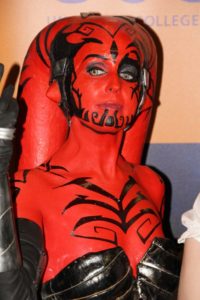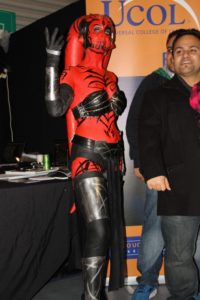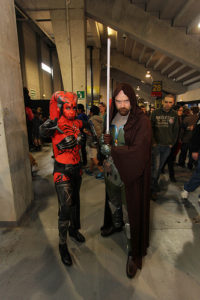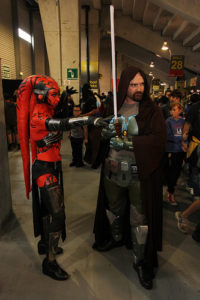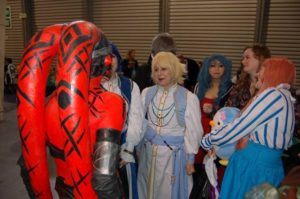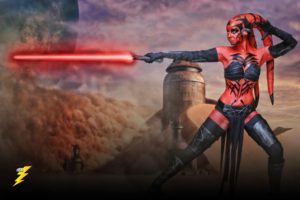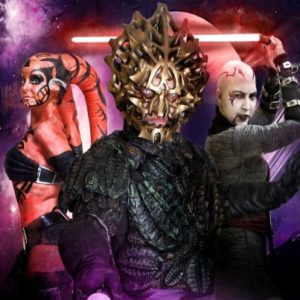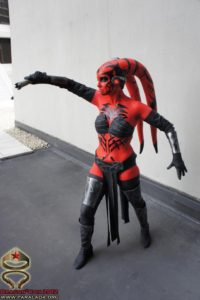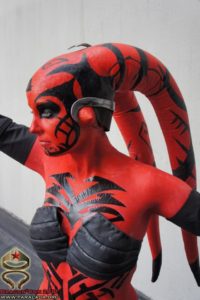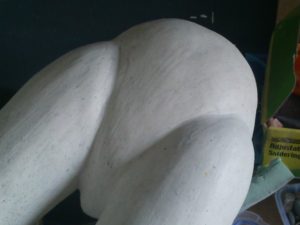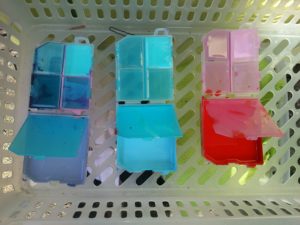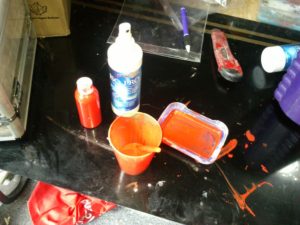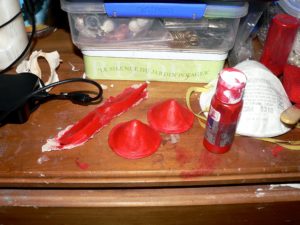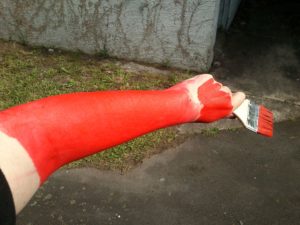– darth talon
Status: Wearable
Year finished: 2013
To Do: replace several costume components
Updates since last photo: n/a
Inspiration: Darth Talon as drawn by Jan Duursema in the Legacy comics. Mark II
(Photos by Behind the Themes)
Photos by “poetprince” on Flickr- no longer available.)
(Worn at Wellington Armageddon Expo 2013, photos link to original uploads)
Mark I
(We Are Sith. Photography and editing by SGH Worn at Dragon*Con 2012)
(Photos by Thomas Spanos)
I debuted this costume in the US for many reasons ???? I almost didn’t wear her at D*C in 2012 because the day before I collapsed after the parade and spent the evening with a cold towel around my head.
However with a lot of help from my friends it wound up one of my most cherished costume events ever. I was incredibly humbled by the care and help I received that day as well as really enjoyed making people happy (did not feel at risk at all in either hotel despite the crowds- probably because it was during the day ???? ).
This costume comprises of many parts and it’s not all finished! However I hope that a breakdown of each part will help others in their ambitions of creating this costume. The more variations and methods to choose from the better! (Lekku, Body paint, Tattoos, Armour, Costume, Wearing)
Lekku
These are perhaps the first purchase or piece to make. She is after all primarily of an alien species and these can make or break the costume, or at the very least you have a costume component that can be used for another costume! Twi’leks look different from media to media and vary from subtle to extreme in length and curve! I have used several methods to create large latex prosthetics and can’t recommend one over the other. It all comes down to personal needs and experience.
Sculpting, negative mold, positive cast:
This is the most traditional method used in the industry. If you are making a slush cast liquid latex piece all you need is the outer negative mold. If you are casting a solid foam piece you need the headshape as well.
(I do have a set of molds to repair so as to eventually make some foam latex pieces!) I have been offered the use of a foam latex oven and help in the casting process, so I may have to spend some time stabilising and repairing my molds.
These molds were made by sculpting a set of lekku, making a skin to test the proportions and then resculpting in water based clay and covering in epoxy resin and matting to make a negative mold. These were sculpted without a curve because I was always intending to make these from foam (either cold cast or latex) and so didn’t need to have a curve. This also allows for little “fat rolls” to form on the underside as can be seen in the games or original lekku.
These are not suitable for slush cast latex as the latex will not stretch and flex enough to create the curve, no matter what it is filled with. A negative mold with all the skin texture and curves you need is relatively easy to slush cast with liquid latex (recommend a brushable as well as liquid thickness) and then stuf.
I recommend fine polystyrene beads as used in travel pillows that fit to shape. These are a little heavier than regular beads but do not create lumps in the surface of the lekku. Best of all is airforced fibre fill used to stuff toys rapidly. Not exactly in the every day kit! The stuffing will also stretch and warp the latex so this is a stage where a lof of care needs to be taken.
Especially vital is the stuffing of the top curve of the lekku. They have a tendancy to fold underneath if not well supported.
Positive mold, sleeve cast: I have done this also for my first set of lekku for my Shaak Ti costume. I used pipe as a base and used space filler (rigid urethane foam) and fibreglass to create the actual shape of the lekku. Then painted latex directly in top, powdered and peeled them off before filling with micropolystyrene beads. It took a week for each as the latex needed to be very firm to cope with being stretched over the form. Latex shrinks as it cures so your form also needs to be strong. This is a relatively easy method but is dependent on your brush skills. For Shaak Ti I was able to use the brush strokes to my advantage to create depth and texture in person and in photos. For twi’lek this is not so easy.
Skinning foam This is how I made my lekku. I had first experience with my Shaak Ti molds. I cast the negative molds in a very flexible cold cast foam and painted a letex skin over that. The foam flex is reduced by at least half in this process simply due to the latex not flexing as well as the foam.
I used a fairly game-like shape for my first set of Lekku (Now used for Rachi Sitra) and more like the Gentle Giant statue of Talon for my second set. I call them Unleashed given the tendency to use this word when marketing oversized product ???? I made the base for both from shaped urethane foam which I then skinned with liquid latex, coating layer by layer and finally dusting with talc to allow paint to adhere as well as prevent the latex from self sticking! The liquid latex was tinted using acrylic paints to a flesh tone- this allows the latex to act like skin underneath the body paint making them more skin like. This does mean they are prone to patchiness with the paint but that just means more care ????
The latex was clipped to shape around the hairline, though I still need to fix this on my second set. Heads are slightly asymmetric and my lekku are as well! I’d like to thin the edges on my second set and will do so with a polishing tip on my engraving tool (lower power than a rotary tool, also lighter) as Twi’lek Pam outlines on her site. Highly recommend her lekku- I don’t own a pair but they always look good in person when I have seen others wear them ????The earbuds I sculpted in plasticine and molded in plaster. I have made several sets and the mold has lot a lot of detail. I will redo these in Ultracal at some stage! Casting has been very tricky due to cure rates and trying to cast in very damp and cold conditions.
Body paint I used two brands of paint (Latona’s Ink and Reel Creation) as well as PAX (Prosthetic Aide and Acrylic paint).
(Custom paint palletes in polyprop. pill containers for easy travel, l-r: Rachi, Liara and Talon/Shaak Ti. The polyprop, has flex so will not break in transit.) The paints I use for my alien costumes are all Alcohol Activated. There are several brands to use. The ones I use are: NZ Airbrush Tatoos Mostly for my white based paints. So for Liara and Rachi. It’s a good product, with amazingly fast response from the owners and they pack the bottles nicely. And cost effectively. Also on TradeMe and I may use their auctions next time so I can leave feedback ![]() These are in liquid form, ready to airbrush. It’s fairly thin so you do need to evaporate off some of the liquid if you want to paint/sponge on. Reel Creations I live in New Zealand so can’t buy their paints easily, but the liquid form is apparently already mixed to use in airbrushes as well. I buy their Large Color Pots as they are totally evaporated and so don’t pose a risk to shipping by air. Oh heck, I worked out how much they cost in NZ dollars. But it’s about $24 each including shipping? But one pot of red lasted multiple applications for Darth Talon including the lekku. harder to remove than the above but still needs hot water and soap at least. IM is best and IA works. Just avoid the face. Latonas which seems to have changed their bottles and maybe formulation? This is close to PAX as you can get without being PAX. It is/was half diluted, so you need to thin it for airbrush but works well as is to sponge on appliances. It is super durable. I did my underarms and butt/thighs as Talon and I looked like I had red boy shorts on the entire time at C6 and some way in to D*C. Even with IM to remove it.
These are in liquid form, ready to airbrush. It’s fairly thin so you do need to evaporate off some of the liquid if you want to paint/sponge on. Reel Creations I live in New Zealand so can’t buy their paints easily, but the liquid form is apparently already mixed to use in airbrushes as well. I buy their Large Color Pots as they are totally evaporated and so don’t pose a risk to shipping by air. Oh heck, I worked out how much they cost in NZ dollars. But it’s about $24 each including shipping? But one pot of red lasted multiple applications for Darth Talon including the lekku. harder to remove than the above but still needs hot water and soap at least. IM is best and IA works. Just avoid the face. Latonas which seems to have changed their bottles and maybe formulation? This is close to PAX as you can get without being PAX. It is/was half diluted, so you need to thin it for airbrush but works well as is to sponge on appliances. It is super durable. I did my underarms and butt/thighs as Talon and I looked like I had red boy shorts on the entire time at C6 and some way in to D*C. Even with IM to remove it.
(Process of painting the oversized Mark II lekku. Two bottles and about 1/2L of alcohol- also used for cleanup.) The Latona’s was used to paint the red on my first set and the red and black on my second set of lekku. I simply brushed the paint on in both cases as well as added an airbrushed layer on my second set. I highly recommend this second method to get a lot of coverage quickly and evenly. The patterns were hand painted in PAX for my first set and used the patterns seen in SW:TOR as I intended on using the lekku afterwards to recreate my in game Sith Inquisitor. However the lekku have a new life as rachi Sitra! I use reel Creations large colour pots to easily travel with paints! Given both kinds of paint are only useable when mixed with alcohol this means being able to travel by air, or to get the pots couriered! They are easily used with a brush and alcohol or can be dissolved in alcohol and used in an airbrush.
(This wide flat brush does give a good even coat when used perpendicular to the surface and with the bristles well soaked. But an airbrush gives a good matte effect and is easier to overcolour with powder/waterbased make up and to remove-last image shows the texture.)
Tattoos The body tattoos are available from Jan Duursema herself as a small jpg where they are displayed like a bear rug- but with the belly intact rather than the back. I took these and rescaled them to my approximate height, cut them apart digitally and then printed these after passing through a few filters to tidy them.
I used these as they were for my first wearing and then I reshaped and proportioned them for my debut in New Zealand. I am currently reworking these again by hand drawing then using photoshop to create paths and selections for a very smooth and easily scaled set. In order to allow me to dress myself or use minimal help I have printed the body tattoos on to various brands of waterslide Temporary Tattoo Paper. I have used World Paper brand and The Amazing Raymond‘s brand and found them both easy to apply. However Raymond‘s is infinitely easier to work with! The quality of the tattoo once applied is very much the same but the ease of application is easier as is sticking the backing to the tatoo. I have used only the inkjet paper. This is due to being able to set them with water. The lazer printer paper is set with alcohol which most definitely does remove the base paint! You also need to clip close to the tattoo shapes but leave a narrow unprinted edge in case the edges wrinkle back while transferring.
(To test the new paper I cut a scrap of unprinted transfer in to a heart shape. I then painted my hand and stuck the transfer on top of the paint. It is glossy and not quite as flexible as the paint underneath, but the tattoo shapes are a solid block of colour and so can cope with being a distinctly different texture. Alcohol will knock out a lot of the gloss but it leaves the surface sticky and incidentally removes any unprotected paint!) The lekku patterns were created by first wrapping the lekku in sandwich wrap and a rough placement of the most obvious patterns seen in the artwork. The specific shape of the patterns changes from panel to panel and book to book but the general shapes are readily identified. These were then overdrawn on more wrap and retraced on to A4 printer paper and hand coloured. Then they were scanned and tidied in photoshop and inserted into an Open Office document and finally exported as a PDF. Accounting for scale changes all the way.
This was then printed and the shapes transferred to adhesive backed craft foam to create stencils that stayed in place on my lekku and an airbrush used to fill in the colour. Hand painted did not work, it seeped under the stencil, but airbrushing worked very well. I had to repaint with red to disguise the overspray though!
Armour
The shins and bicep pieces are cut from PVC down pipe. Had I been able to afford more in wider diameters I would have made the thigh and belt pieces from the same material as it is easy to heatshape whithout warping. However I was not able to do so and I did have a large amount of 3mm sheet styrene which I used for the thigh, belt, headwrap and forearm pieces. These were all shaped with a heat gun and shocked into shape with cold water in a bucket. I would recommend making as much as possible from PVC downpipe as it tends to not warp even with repeated heatshaping and can be flattened in the same manner.
The pieces were all sanded back to a satin-matte finish and saber marks tooled in with a rotary tool. These were with a mix of drill bits and engraving tools. Engraving tools tended towards a stuttered effect which I then sanded out as much as possible with the folded edge of sandpaper. The same rotary tool was used to drill out holes for rivets and snaps. The paint is a gloss acrylic spray paint which adheres wonderfully to sanded PVC without the need for a primer. Then I used silver rub ‘n’ Buff to highlight the cuts and buffed the rest back to a more subtle graphite silver. In my NZ debut I also used some gold Pearlex and alcohol to warm the silver. It is subtle in photos but does give a more natural tone in person as well as photos.
I made my own straps by topstitching strips of PU coated fabric also used to rebuild and cover my boots.
The thigh and bicep pieces are riveted through the straps on both sides but the shin and forearm pieces have one side riveted and the other velcroed.
The belt is made from 2.5mm vegetanned shoulder which is tooled with a swivel knife, edge beveller and push beveller. It was then dyed with Feibing’s leather dye in black and polished with Dubbin on the raw and finished sides. I used heat to help the waxy polish to penetrate both sides of the leather and then manipulated by hand to resoften. The belt is riveted on the front and snapped in the back. The straps are straight but the front and back cut on an angle so it arches over the hips.
The headpiece is made from a strip of Styrene shaped in to a U and treated as per the rest of the plastic armour. The antenae is made the same way and is unattached to allow for easy transport- the tension between lekku and headpiece holds it in place. The lower half of the headpiece is made from shaped and dyed leather. This was then glued with Shoe Goo (E6000 or Goop would work the same way) to allow for maximum flex to allow it to be fitted in place for each wearing.
nd repositioned.)
Costume
The leggings, gloves, bikini briefs and arm covers were all made from a vulcanised rubber coated heavy lycra. The fabric base is extremely heavy, closer to rugby jersey than swimsuit material, and the rubber coating very durable s it was intended for use in making scuba gear!
The boot covers were shaped and glued to fit over a pair of ankle boots that were cut does to slipper shape.
The fabric used has a fleece backing and is quite heavy- it was intended for making coats and jacket type garments. It also has a good amount of horizontal stretch to allow the boots to slip on.
The boot base is a low wedge, with a shallow platform that can be seen quite distinctly in several panels of the comics. These got badly damaged while travelling in a very humid and hot climate so will be repaired for the next wearing.
The hanging strips on the belt were cut from the same fabric.
The bikini top is currently built over a strapless bra and from the same PU fabric as the boots at the front and the same scuba material at the back. I am currently testing both wonderflex and vegetanned leather (1.5mm) depending on whether I can stretch the leather over the form. There are two distinct shapes to the bikini top- a V and a flatted U.
The current bikini top has the V shape but the test pieces are going to have the flattedn U as both materials will hold shape against gravity!
Wearing
Equipment: Two large foundation brushes (~1″ wide)- painting Two large flat brushes (~1 1/4″ wide)- painting One medium flat brush (~3/4″ wide) – gluing Several fine line brushes- painting details Small cheap shaped brushes for glue and latex work Wide flat containers- storage Small shallow container- soak brushes in alcohol for painting then cleaning Hand towels- protect the area from paint splashes Dish cloths- for cleanup Sandwich bags- tidying and carrying
Product: Paints- in flat palettes Temporary tattoos Alcohol- isopropyl or grain, over 90%- never below- for painting and clean up Prosthetic Aide- an acrylic based glue- do not use spirit gum Cabosil- fumed silica to thicken PA to build up shapes on the skin Eyeshadows- for matting skin on eyelids False lashes Stay put lipstick- optional, a subtle shade of difference of the lips can help define them Moisturiser
First prep the skin: Start this at least two weeks before with an intense moisturing regime. I use Aveeno but it really does depend on what you skin needs are. But you want to plump the skin as much as possible because the paint is very dehydrating and so is the painting process which can last several hours! The paint will last several days but it starts looking bad by the second day due to the drying effects it has. In the few days leading up to the event defoliate everything you can stand to defoliate! this includes hairs around the hairline, I will essentially remove up to 1/2″ from the back of my hairline and 1/4″ at the front. This allows for more surface area to glue your lekku and’or bald cap to and avoids the glue from gumming too much hair (easier cleanup) and also to allow for a smoother finish to the paint- hairs get coated individually even with a hand brush! The morning of the event have a good hot shower and moisturise with a non greasy moisturiser. I still use Aveeno but then wipe off excess with a towel and then spritz a light spray of alcohol to knock back any excess oil.
Prep the area In order to be as efficient as possible and make the painting easier I put my equipment and products into different shallow dishes or containers: In one container I lay my brushes flat, from line detail through to wide flat brush so as to easily pick up and use. I also have multiple brushes in case of any accidents or cleaning issues. In another I open the base paint palettes. In the next is the alcohol in a bottle and shallow container. In the next I put my glues and liquid latex and tool to apply them. In another I put my mascara and powders and any extra items. The tattoos are kept far enough away to avoid being splashed or otherwise damaged but within reach and in order of application. I put a hand towel in the sink and hang extra towels/rags over the bath tub and put any hotel towels/cloths far far away! I also get my on site bag handy so as to drop anything I need in it as I finish each stage. At this stage I put in my contact lenses so as to be able to see what I am doing! And put the lens case in my on site kit!
Start painting In order to avoid setting off hotel alarms, being able to paint myself without help and to avoid overspray I paint by hand. I do a rough coat with a wide flat synthetic brush and then tidy with a large foundation (or filbert shape) brush. The brushes have handles cut off to allow for contorting to see the layers and to try and get right up and between my shoulder blades. It helps prevent banging the brush on the mirror when getting in close for detailed paintwork. I paint mostly with horizontal strokes to help disguise paint marks- we associate uneven paint with drip marks which are vertical. Or a shallow V over the chest, again to disguise any paint lines. The alcohol in the paint evaporates quickly so this means you can get a lot of coverage done quickly but you do need practice to avoid paint lines due to one layer of paint dissolving the next. This heavy layer goes from under my chin and around my ears down to 2″ below the bikini brief line and starts again the same distance from the bottom of the bikini brief line and to a similar level below legging line. This is in case of costume slippage. This is at least two hours work so take the time and relax as much as possible! I drink a lot of tea- green or regular, but generally slowly sipping to stay hydrated. Once the paint is on you can start sticking the tattoos. Usually you need to peel off the clear backing and stick the card side to your body. Then you soak a cloth in water, wring it out a little and pat the card until the slide is released. To speed this process up I use hot water (shower hot, not scalding!) and really soak a cloth and then place that over as much card as possible. The water pours off you but the alcohol and tattoo are perfectly safe! The card will slip off very quickly as well. Just be careful as some card can stick to the tattoo or the edges can peel a little. Let the card slide off- don’t be tempted to pull it off too quickly. I then put on the bikini and paint my face. Again a foundation brush for the base colour then a fine liner for the tattoos. As a handy reference either print the face pattern at full page size or have it on your laptop/netbook screen. Reverse it and mark it as reversed/mirrored! I have spent a few hours freaked out that I had them backwards! Leave your forehead free of paint, otherwise the glue to hold your lekku in place will stick to the paint and not your skin. Talon has some epic lashes in the comic so feel free to wear false lashes! I also glue stick my eyebrows to protect them from the glue and to create a smooth brow. I also use a black eyeshadow on both eyes to help create definition and to prevent the paint cracking in eyelid creases
If you have a way to travel to the venue, I recommend carrying your lekku and other costume pieces to site and finish gluing and painting there. It’s easier than dealing with a cabbie freaking over your paint on their seats and trying to sit with ginormous tentacles getting in the way!
Gluing the lekku
This can be the make or break point. Physically as well as in actuality. I recommend also carrying a scrap of stretch fabric or a set of headwraps to hide the seam just in case. There is no reason why Talon could not be wearing headwraps, it just wouldn’t be from her appearances in the comics ???? I usually put my hair in two small buns when wearing any of my latex prosthetics (Twi’lek, Togruta and Asari so far) but the balance of my second set of lekku is better with a single bun at my crown. The lekku headpiece as a slight conical shape like the originals 9though not quite as pronounced) so the bun settles in there nicely. I avoid using bobby pins anywhere there will be pressure so use flat hair clips instead as these are curved to shape and are wide enough to dissipate pressure. I usually glue a blad cap in place first but I regularly get fluid in my eustachian tubes (tubes from nasal passage to inner ear) and if my ears are sealed in a bald cap this can be so bad as to cause me to get nauseated or otherwise ill. Holes cut over the ears help but occasionally you can just glue the lekku directly in place.
I use a 3/4″ wide flat brush to apply a fast and relatively thin layer of glue over my forehead and in front of my ears and the back of my neck- leaving a gap at the very back to allow for some airflow and a place for sweat to drain- yes, yes you should do this because even with an exposed torso your head will perspire heavily and if the sweat has nowhere to go you get heat buildup. Then it is a case of very quickly placing the lekku! There will be just enough time to position and reposition before the glue sets, either sticking lekku in place or drying over the skin. But you can get a smaller brush to fill in any gaps. The trouble spots are usually in front of the ears as this is where the jaw hinges.
Once set in place I mix cabosil and prosthetic aide to a thick paste- thicker than toothpaste, and spread it over the seam line, trying to build up on the skin to be level with the latex. A thin layer over the latex helps the whole bind together. You need a flat metal tool (flat probe tool in a disection kit! Or they are sold and small spatulas for make up). I used the end of a metal nail file as it was flat and had a bevelled edge for safety. If the bondo is sticking more to the tool and not laying flat, wet your finger tips and pat the bondo down. You will need to wet your finger tips several times so it doesn’t stick to your hands. If you get build up on your hands take a moment to clean them alcohol and let them dry and start again. Do *not* use Isopropyl Myristate during the painting stage. It is very powerful and over time it will transfer to your paint job and ruin it. I then stipple prethickened latex over and again repeat with wetting my finger tips to smooth. This seems to be the easiest and more predictable method of smoothing. Once fully cured you can use your paints to hide the join and match the lekku patterns to your facial patterns. To remove: The tattoos will probably show some signs of wear at the end of a long day so you can start peeling them off.
Remove your contact lenses! Fill a basin with hot water. Put in your face cloth. Take out and wring then put on your face. This is like having a nice steam facial and helps by getting your face sweating. Do this a few times and be careful. You want that theraputic heat not scalding heat! Next use same face cloth with a gentle soap. Gently use the cloth and soap on your cheeks and jaw and the less sensitive areas. Leave any hard to remove patches until after the next step. Turn the shower on as hot as you personally can stand it. Do not have a bath at this stage and don’t use Isopropyl myristate, alcohol or oil yet. Stand in the shower and warm up. The paint will still not come off at this stage! Take your dish cloth or terry cloth and soap it well. Keep the cloth sopping wet with the shower water and soap and gently scrub. You will know your own limits and skin sensitivity. I use the hotel soaps as they tend to be vegetable based and very gentle. This should remove the majority of the paint. As you are scrubbing the paint and not dissolving it, clean up of the cloth and shower curtain (pretty sure you’ll get splash marks on one!) is very easy- rinse in warm water. If you were to have a hot bath and use alcohol or Isopropyl myristate you can make the paint gummy and so stick to surfaces and be difficult to remove. Turn off the shower and step out on to one of your towels and dry with another. If you have some stubborn spots of glue and paint use the Isopropyl Myristate now. Gently rub it in to the glue and leave for a moment before cleaning off with a warm cloth. You can also use baby oil or another oil you prefer. It is essentially heat, massage and oil that will help at this stage. And finally moisturise! Slather the stuff on and you’ll probably find it helps remove the very last specks from your face and neck. For the face I also use a good big dollop of Aveeno and work then in to the skin already cleaned and in to the edges of the paint to help lift it. The heat from the face cloth, the moisturiser and gentle buffing action will remove most. (I use this to remove street make up too). If you use IM or oil remember to also then clean your face with a gentle cleanser and use your moisturiser. They are oily so can clog pores.
A brief comparison of lekku in current media: The original: Oola’s lekku (in Return of the Jedi) have a very obvious liquid latex skin as it folds in loopy shapes rather than distinct rolls as occur naturally, most certainly over a foam latex base. She also has a slight cone shape to the crown of the head as well as distinct joins of the lekku to scalp. Lyn Me in the extended special editions also seem to be built in a similar method. The lekku arc in a low curve from the join and flare out from the sides of the head a fair bit to allow them to hang over the shoulders. Prequels: Most of the Twi’lek extras (each word is linked to a different Wookiepedia entry) have lekku that are sculpted with a distinct curvey S shape and are quite tapered from a wide base to pointed ends. They also arc quite sharply from the base and do not flare as much outwards though they are also able to hang over the shoulders. Whether these are foam or slip cast latex is a little open to debate until someone obsessively watches them. Ehem. Maybe soon ???? Aayla‘s however are very narrow and floppy in comparison- most definitely foam latex. She also has some bumps near her forehead which are similar to those of the male Twi’lek (Bib Fortuna) in Return of the Jedi. Also of note is the use of a bald cap to smooth the back of the head and allow her headwrap to sit closer to horizontal than if it were to cover her full hairline. Other Twi’lek extras occasionally show stray hairs near the nape of the neck! Games: In Knights of the Old Republic lekku are quite short and come from the sides of crown rather than further back. In Star Wars: The Old Republic lekku are longer (to upper hip) but also come from further around the side of the head. They have very distinct rolls on the underside fo the join. Comics: Generally speaking as luxuriously curvy and oversized as possible! Also clearly opposable!
